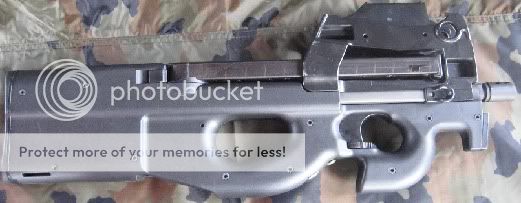
Weapon Name- P90
Type- Sub-Machine Gun
Damage- 0L
Range- 50/100/200
Ammunition- 2000 rounds per 27.5 lb
Strength Level- 2
Strength Level for firing- 2 for burst, 2 for medium burst, 2 for automatic burst
Special Consideration- +1 to initiative.
Round Type- 5.7mm x 28mm
Over-all length- 500 mm (19.7 in)
Barrel length- 500 mm (19.7 in
Weight- 2.54 kg (5.60 lb) empty
2.68 kg (5.9 lb) empty magazine
Rate of Fire- 650 rounds/min (600 rounds/min for UMP45)
Feed Mechanism- Top Fed Stacked Detachable Box Magazine
Round Capacity- 50 rounds
Accuracy- 2 MOA
Accessories- Picanty Rail
Quick switch firing mechanism- N/A
Scope/Sights- Picanty Rail
Muzzle Velocity- 900 rounds/min
Firing System- Straight blowback, closed bolt
Miscellaneous/electronic information-
Basic Information
The P90 was developed by FN between 1986 and 1990 in conjunction with the 5.7x28mm cartridge. FN's goal was to replace the pistol-caliber submachine guns which were in use at the time by military and law enforcement personnel, as it had become evident that such weapons were ineffective against body armor.[4][13]
Initially the weapon was designed to use a 5.7x28mm cartridge called the SS90.[4] The SS90 propelled a 1.5-g (23 gr) plastic-core projectile from the P90 at a muzzle velocity of roughly 850 m/s (2,800 ft/s).[4] The first prototypes firing this ammunition were completed in 1987, and over 3,000 submachine guns were produced in this configuration until 1993, in a low-rate trial production mode.[14][15] Shortly after its introduction, the weapon was adopted and used in service with the Belgian special forces group in the 1991 Gulf War.[1]
Following the P90's introduction, FN revised the 5.7x28mm ammunition and abandoned the SS90 variation.[4] The new variation, designated the SS190, used a projectile 2.7 mm (0.11 in) shorter in length than that of the SS90.[4] This allowed it to be used more conveniently in the 5.7x28mm FN Five-seven pistol, which was under development at that time.[16] This projectile also had a heavier weight and more conventional construction containing an aluminium core and steel penetrator.[4][17][18] A modified version of the P90 with a magazine adapted to use the shortened ammunition was introduced in 1993.[16] Several special cartridge variations were also developed, such as the L191 tracer round and the subsonic SB193 bullet for use with a sound-suppressed P90.[17]
Further development of the P90 platform led to the creation of the P90 TR variant, which has a MIL-STD-1913 top rail system. This variant was introduced in 1999 and continues to be offered alongside the standard P90.[6] More recently, the P90 has been offered to civilian shooters in various configurations as the PS90. This is a semi-automatic sporting carbine with a lengthened 407 mm (16.0 in) barrel.[19]
[edit] Design details
The P90 is a selective fire straight blowback-operated weapon, that fires from a closed bolt.[2][3][4] The return mechanism consists of two parallel spring guide rods that also guide the bolt carrier assembly. The weapon's 263-mm (10.39 in) hammer-forged steel barrel is fitted with a ported, diagonally cut flash suppressor that also acts as a recoil compensator.[5]
Photo of a disassembled PS90, showing the major component groups: 1. trigger group, 2. barrel and optical sight assembly, 3. butt plate, 4. magazine, 5. bolt carrier and recoil assembly, 6. stock body and trigger.
A disassembled PS90, showing the major component groups: 1. trigger group, 2. barrel and optical sight assembly, 3. butt plate, 4. magazine, 5. bolt carrier and recoil assembly, 6. stock body and trigger. The standard P90 disassembles into similar main components.
The P90 is designed in the bullpup configuration, in that the action and magazine are located behind the trigger and alongside the shooter's face. This reduces the firearm's overall length, because there is no wasted space in the buttstock as in conventional designs. The P90 is fully ambidextrous—it can be operated by right or left-handed shooters with equal ease, and without making any modifications to the weapon. The charging handle, auxiliary fixed sights and magazine release are symmetrically distributed on both sides of the firearm. The manual fire selector below the trigger can be operated from either side. Spent cartridge casings are ejected downward through a chute located aft of the pistol grip, keeping fired cases out of the shooter's line of sight.[1][2][4]
The pistol grip has a thumbhole and oversized trigger guard that acts as the forward grip, and a protrusion is incorporated into the front of the weapon's stock to prevent the user from accidentally reaching out in front of the muzzle during firing.[4] The P90 is a modular firearm and consists of 69 parts that disassemble into four main groups: the barrel with integrated sight assembly, the receiver with return mechanism, the stock body with trigger and firing mechanism, and the magazine. The weapon's design makes extensive use of polymers and lightweight alloys to reduce both the weight and the cost of the weapon.[4]
The P90 uses an internal hammer striking mechanism and a trigger mechanism with a three-position rotary dial fire control selector, located at the foot of the trigger. The fire selector also provides a manual safety against accidental firing. The dial has three settings: "S" – safe, "1" – semi-automatic fire, and "A" – fully automatic fire. When set on "A", the selector provides a two-stage trigger operation similar to that of the Steyr AUG. Pulling the trigger back slightly produces semi-automatic fire and pulling the trigger fully to the rear produces fully automatic fire.

